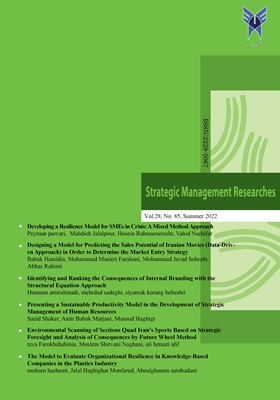Designing a Model for Predicting the Sales Potential of Iranian Movies (Data-Driven Approach) in Order to Determine the Market Entry Strategy
Subject Areas : Strategic Management Researches
Babak Hamidia
1
![]() ,
Mohammad Masteri Farahani
2
,
Mohammad Masteri Farahani
2
![]() ,
Mohammad Javad Sohrabi
3
,
Abbas Rahimi
4
,
Mohammad Javad Sohrabi
3
,
Abbas Rahimi
4
1 - Assistant Professor of Imam Sadegh University, Tehran. Iran
2 - Student of Imam Sadegh University, Tehran. Iran
3 - Student of Imam Sadegh University, Tehran. Iran
4 - Student of Imam Sadegh University, Tehran. Iran
Keywords: Forecast, Movie Sales Potential, Box Office Sales, Factors Affecting Iranian cinema demand, Market entry strategy,
Abstract :
Having a predictive mathematical model regarding the sales potential of movies before the marketing and screening of movies is one of the needs of many producers, Cinema owners, etc. In this research, based on a systematic process and mixed exploratory approach, first the factors affecting the sales potential of movies were calculated and classified by content analysis method and by selecting the content factors of the film, i.e., the factors affecting the probability of pre-marketing and screening; The status of each of these factors in the top 100 films of a decade of Iranian cinema was examined. The required data were extracted from the statistical yearbook of Iranian film and cinema sales and based on Shannon entropy method and based on real data of 100 popular Iranian films, model coefficients were extracted and finally, a mathematical model to calculate the sales potential of a film up to Extracted before the marketing phase. The results of this study indicate that the 4 main factors of director (with coefficient of 0.25), actor (with coefficient of 0.253), genre (with coefficient of 0.251) and technical quality of film (with coefficient of 0.246) and a sub-factor of film series (with extra score) affect the sales potential of a movie.
Abedi Ja’fari, Hasan; Taslimi, Mohammad Saeed; Faghihi, Abolhasan; Sheikhzade, Mohammad (2012). Thematic Analysis and Thematic Networks: A Simple and Efficient Method for Exploring Patterns Embedded in Qualitative
Data Municipalities). Strategic Management Thought 5(2).
Dehghanpour, Hamid; Mosalla, Mahsa (2016). Identifies Film Value Chain and its Impact on Sales Growth. Honar-ha-ye-ziba: honar-ha-ye mosighi va namayeshi 20(2).
Elberse, Anita (2007). The Power of Stars: Do Star Actors Drive the Success of Movies? In Journal of Marketing 71 (4). pp. 102–120.
Eliashberg, Jehoshua; Jonker, Jedid-Jah; Sawhney, Mohanbir S.; Wierenga, Berend (2000): MOVIEMOD: An Implementable Decision-Support System for Prerelease Market Evaluation of Motion Pictures. In Marketing Science 19 (3), pp. 226–243.
Fathi, Zohreh; Khamoushi Esfahani, Pante a. Statistical Yearbook of Iranian Film and Cinema Sales (2010-2020). Deputy of Technology Development and Cinematic Studies. Ministry of Culture and Islamic Guidance.
Galvão, Marta; Henriques, Roberto (2018). Forecasting Movie Box Office Profitability. In Journal of Information Systems Engineering & Management 3 (3).
Geraeinenezhad, Gholamreza; Hadi Nezhad, Manijeh; Bakhtiari, Arezoo (2011). Investigation of the Factors Affecting Demand of Iranian Cinema. Culture-Communication studies 11 (9).
Ghiassi, M.; Lio, David; Moon, Brian (2015): Pre-production forecasting of movie revenues with a dynamic artificial neural network. In Expert Systems with Applications 42 (6), pp. 3176–3193.
Kim T, Hong J, Kang P. Box Office Forecasting considering Competitive Environment and Word-of-Mouth in Social Networks: A Case Study of Korean Film Market. Comput Intell Neurosci.
Nourbakhsh, Seyed Kamran; Shafiee, Bahareh (1393). Investigating the role of promotional components on increasing film sales. business management. 6 (22), 27-39.
Poordeljo, Amir Hussein (1396). Investigate market entry strategies with the appropriate time strategy implementation approach. Eleventh International Conference on Strategic Management. Tehran.
Salavatian, Siavash; Rohbakhsh, Mahnaz; Derafshi, Ahmadreza (2019). Factors Affecting the Marketing of Iranian Filmmakers Through Social Media. Culture-Communication studies 19 (41).
Sawhney, Mohanbir S.; Eliashberg, Jehoshua (1996): A Parsimonious Model for Forecasting Gross Box-Office Revenues of Motion Pictures. In Marketing Science 15 (2), pp. 113–131.
Selvaretnam, Geethanjali; Yang, Jen-Yuan (2015). Factors Affecting the Financial Success of Motion Pictures: What is the Role of Star Power? In Discussion Paper Series. School of Economics and Finance.
Sharda. R; Delen. D. (2006). Predicting box-office success of motion pictures with neural networks. In Expert Systems with Applications 30 (2), pp. 243–254.
Sochay, Scott (1994). Predicting the Performance of Motion Pictures. Journal of Media Economics 7(4). pp 1-20
Sood, Niharika; Balamurugan. J (2017). Factors Affecting the Success of Movies-A Case Study of Twin Movies (2). International Journal of Innovative Science and Research Technology.
Tolouei ashlaghi, Abbas; Saghaei, Abbas; Khorsandi Karimi, Sara (2011). Predicting the sale of movies in Iran using neural networks and comparing it with statistical methods. Media studies 5(11).
Zhang, Li; Luo, Jianhua; Yang, Suying (2009). Forecasting box office revenue of movies with BP neural network. Expert Systems with Applications 36. pp 6580–6587


